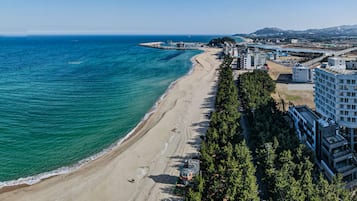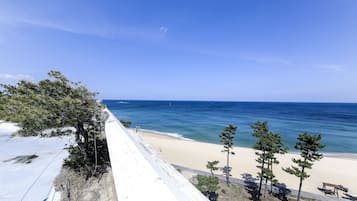Thanks to its location by the East Sea, Gangneung is often associated with seafood. However, Gangneung also has a robust agricultural sector, thanks to abundant precipitation. The crops produced in this region include not only rice, but also potatoes, maize, and buckwheat. These crops have led to the development of delicious dishes like makguksu (spicy buckwheat noodles), gamja ongsimi (potato ball soup), and Chodang sundubu (soft bean curd). Gangneung is also famous for its hanu (Korean beef), grown in rich green grasslands surrounding the city.
Gangneung is rich in fisheries with squid being the most famous of all seafoods. Indeed, squid is so beloved by the people of Gangneung that a squid festival is held every year along with a rite held by traditional fishers. Many local recipes feature squid, and the king among them is ojingeo sundae (stuffed squid). Expand your horizons with delightful local fare that takes after this city between the mountains and the sea.
- 1
Makguksu
Find your golden ratio of sugar, vinegar, and mustard

- Essen
Makguksu (spicy buckwheat noodles) are served in many restaurants around Gangneung. Buckwheat noodles are not as elastic as wheat noodles, so they break easily. It is said that the name of the dish (makguksu) refers to how one would use spoons to spoon the noodles into one's mouth, but like any good local legend, its veracity cannot be confirmed. What's clear is that the noodles come from a time of less abundance, when one was less picky about food. A simple dish of buckwheat noodles, eaten simply with kimchi or in a broth of radish water kimchi. Today, however, it is a proud member of locals' favourites in Gangneung.
The more well-known version of this dish uses a spicy sauce to dress the noodles, but Gangneung's version tends to be less spicy, or even served completely heat-free in radish water kimchi. Given that the noodles play on more delicate flavour, there's a greater imperative to get the ratio of sugar, vinegar, and mustard just right, which can only be achieved with practice and familiarity. Try your hand at finding your very own golden ratio for this dish in Gangneung.
- 2
Chodang sundubu
Fluffy, soft, plain, yet elegant

- Essen
Chodang sundubu (soft bean curds) is a native dish of Gangneung, Gangwon-do and is made with seawater as a coagulant rather than gansu (mixture of magnesium and calcium salts). Traditionally, Chodang dubu (bean curd) is divided into two types, modubu and chodubu. Modubu is ladled into a frame and pressed into a solid block, while chodubu is served without further solidification. Chodubu is what we refer to as a soft bean curd. Restaurants serving dishes made with Chodang dubu can be found in Chodang Dubu Village, located in Chodang-dong, Gangneung.
First-timers may be puzzled at how bland the soft bean curds seem to be. But with each spoonful, the fluffiness, softness, delicateness, and elegantness reveal what makes these bean curds so special. That is not to say that Chodang Dubu Village is not innovating. For younger taste buds, the village serves tofu in spicy soup, either with noodles or seafood. Take your pick!
- 3
Sliced raw rainbow trout
Red flower blooming on a plate

- Essen
In Gangneung, one can sample raw slices of rainbow trout, which are served fanned out on a plate like a red flower. Unlike sea fish eaten in raw slices, such as olive flounder, rockfish, or sea bream, the raw flesh of rainbow trout is red. Sliced raw trout is generally eaten with wasabi and soy sauce in a vegetable wrap, but in Gangneung, they are sometimes made into a salad with vegetables and powdered soybean.
Rainbow trout is a rather difficult fish to farm. They require exacting temperatures, water quality, and volume, so they can be farmed in only a select few places. One such place is Pyeongchang, located quite close to Gangneung, so one can sample rainbow trout in Gangneung. Lovers of classical music will recognize rainbow trout as that of Franz Schubert's Forellenquintett. Make sure to sample the fish in Gangneung!
- 4
Gamja ongsimi
Mouthful of Gangwon's gentle scent

- Essen
Gamja ongsimi (potato ball soup) is one of the most famous specialties of Gangwon-do. Traditionally, the balls are made out of ground potato flour. Its Korean name, ongsimi, was originally a word used to refer to saealsim, rice cake balls, in Gyeonggi and Gangwon dialect. That is to say, both the rice cake balls and potato balls were called ongsimi in Gangwon. Potato balls were used instead of rice balls when rice was not as plentiful in the past. Today, there's plenty of rice to go around, but potato balls continue to enjoy enduring popularity in Gangneung.
And who could say no to soft potato balls, giving way to the firm and chewy texture within? The first taste may be somewhat bland, but with repeated chewing one feels the richness of the potato in one's mouth. The soup itself is made with plenty of vegetables like potato, zucchini, and mushrooms, swimming in a soup made with anchovies, seaweed, and egg, which gave the soup a new wave of popularity as a healthy food. Enjoy the gentleness like that of the people of Gangneung in Gangneung's gamja ongsimi.
- 5
Dakgangjeong
New contender for Korea's favourite snack, made with traditional confectionary methods

- Essen
Gangneung's Jungang Market is a must-visit location in the city. The market offers a variety of interesting and unique foodstuff, and dakgangjeong (deep-fried and braised chicken) is one of the most famous among them. Gangjeong, a type of traditional sweets, is a rather scarce dish that one could only sample on holidays or at ancestral rites. This mixture of grains, honey, rice syrup, etc., deep-fried in a cast-iron pot, has inspired another beloved snack in the form of the dakgangjeong.
One often finds people lining up to purchase the delicacy in Jungang Market. Some restaurants have nearly 50 years of history and enjoy nationwide recognition. Flavours range from mild to slightly spicy and really spicy, with spicy sauce being the most popular. You might wonder if it's all hype and no go, but this is the real deal. Satisfaction guaranteed.
- 6
Ojingeo sundae
Chewy texture and rice al dente

- Essen
Ojingeo sundae (stuffed squid) is a must-have dish in Gangneung. This dish is said to originate from the Korean War, when the aunties making sundae, pork intestine stuffed with blood and other ingredients, used squid instead of pork intestine due to shortages during the war. The dish is created by removing the innards of squid and filling the cavity with glutinous rice, chopped squid, and vegetables. The resulting dish is a simple, yet elegant dish combining chewy squid with al dente rice.
One often finds people lining up to purchase them in Jungang Market, even on weekdays. The sound of knives on knife blocks slicing ojingeo sundae is a part of the market's ambient sound, as much as yellow slices of ojingeo sundae battered in egg wash and fried. Make sure to sample some in Gangneung!
- 7
Gondeure bap
Appetizingly gentle scent of mountain herbs

- Essen
The fragrance of gondeure bap (thistle rice) symbolizes the unostentatious charm of Gangneung. Back when times were harder, thistle rice was often eaten in May, when food was at the scarcest. Gondeure is how the people of Gangwon refer to thistle. Being a hardy and easy-to-grow plant, thistle was often grown in the mountainous regions of Gangneung, a tradition from which thistle rice is said to originate from.
For a mountain herb, thistle has a rather delicate scent when cooked. But this scent, when combined with the scent of freshly-cooked rice and perilla oil, is the reason why this dish gives off such an appetizing scent. Let the rice brown a bit on the stone pot, and get your first spoonful with soy sauce in a separate bowl. The rest can be enjoyed with vegetable wraps, or with soybean paste stew. Don't miss out on the fragrance of thistle rice in Gangneung.
Foto von Republic of Korea (CC BY-SA 2.0) bearbeitet
- 8
Hanu
Meat grilled with the pure energy of Taebaek Mountain Range

- Essen
One finds a surprising number of restaurants specializing in hanu (Korean beef) in Gangneung. The most notable characteristic of hanu in Gangneung is that the beef is sourced from cattle grown in Gangwon-do's unspoilt nature. Clean water from Taebaek Mountain Range and the pristine nature of the highlands make Gangneung one of the most optimal places in Korea for cattle farming. For these reasons, Gangneung hanu attracts great popularity.
Most hanu restaurants in the Gangneung area use beef rated Grade 1 and above. The most popular set-up is the assorted grill menu, which includes a wide range of cuts to be sampled. Grill the cuts on charcoal fire and enjoy them with a green onion salad. You won't be forgetting this taste anytime soon. The customary way to finish the meal is with yukhoe (beef tartare) bibimbap and doenjang jjigae (soybean paste stew). If you want to sample the unforgettable taste of hanu, look no further than Gangneung.
- 9
Osam bulgogi
Novel combination of squid and pork

- Essen
Osam (squid and pork belly) bulgogi is a must-have dish in Gangneung. The dish is said to originate from a time when squid did not fetch such premium prices, as a means to add more weight to the dish in lieu of the (formerly) more expensive pork. Today, however, the dish is enjoyed fully of its own merits. Freshly-caught squid from the East Sea and pork belly sourced from the pristine nature of Gangneung are stir-fried with a marinade made of chilli pepper flakes and paste. The resulting dish has a delightful kick from the chili pepper without being greasy, all served at affordable prices. Is it any wonder that this dish became an instant favourite in Gangneung?
Squid contains high levels of taurine, which helps to prevent circulatory disorders, hypertension, and diabetes. Pork is rich in essential amino acids and unsaturated fatty acids. Don't miss out on this delightful combination: Your body and your taste buds will thank you later.
- 10
Chuncheon dakgalbi
Unique taste of tradition and fusion

- Essen
Chuncheon dakgalbi (spicy stir-fried chicken) is the most popular dish in Gangneung. The history of this dish is said to have begun in the late 1960s, from grilled chicken in a spicy marinade served in pubs. Just like dwaeji galbi (grilled pork ribs), chicken was marinated before being grilled and sold as “chicken bulgogi.” Chuncheon was home to a large number of chicken processing plants, and thus served as the epicentre as the new dish began to spread throughout Gangwon-do.
Gangneung's take on this iconic Chuncheon dish tends to embrace creative fusion fare. The best example of this is spicy stir-fried chicken and cheese (cheese dakgalbi), made with copious amounts of mozzarella. Chicken is first stir-fried, then topped with thick slices of mozzarella. Its popularity rests upon the delectable result of this combination. If Chuncheon dakgalbi is the origin of this tradition, spicy stir-fried chicken with cheese is a fusion dish based on such tradition. Make sure to try the other variations in Gangneung.


















